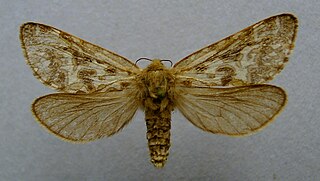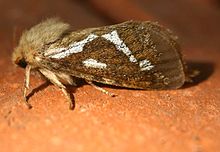
A spruce is a tree of the genus Picea, a genus of about 35 species of coniferous evergreen trees in the family Pinaceae, found in the northern temperate and boreal (taiga) regions of the Earth. Picea is the sole genus in the subfamily Piceoideae. Spruces are large trees, from about 20–60 m tall when mature, and have whorled branches and conical form. They can be distinguished from other members of the pine family by their needles (leaves), which are four-sided and attached singly to small persistent peg-like structures on the branches, and by their cones, which hang downwards after they are pollinated. The needles are shed when 4–10 years old, leaving the branches rough with the retained pegs. In other similar genera, the branches are fairly smooth.

The Hepialidae are a family of insects in the lepidopteran order. Moths of this family are often referred to as swift moths or ghost moths.

The ghost moth or ghost swift is a moth of the family Hepialidae. It is common throughout Europe, except for in the far south-east.

Aenetus is a genus of moths of the family Hepialidae. There are 24 described species found in Indonesia, New Guinea, New Caledonia, Australia and New Zealand. Most species have green or blue forewings and reddish hindwings, but some are predominantly brown or white. The larvae feed in the trunks of living trees, burrowing horizontally into the trunk, then vertically down.
The Hepialoidea are the superfamily of "ghost moths" and "swift moths".

Pharmacis is a genus of moths of the family Hepialidae. There are eight described species found in Eurasia.

Phymatopus is a genus of moths of the family Hepialidae, which consists of around 500 species and 30 genera. The genus was erected by Hans Daniel Johan Wallengren in 1869. They can be found across Eurasia and North America. Species can be distinguished by the different morphology of male genitalia and different forewing patterns, which vary in stripe colour and size and arrangement of spots. The stripes themselves consist of spots separated by dark veins which are fringed by thin black lines from both inner and outer sides.

Triodia is a genus of moths of the family Hepialidae. There are seven described species found in northern and western Eurasia.

Nepenthes gracilis, or the slender pitcher-plant, is a common lowland pitcher plant that is widespread in the Sunda region. It has been recorded from Borneo, Cambodia, Peninsular Malaysia, Singapore, Sulawesi, Sumatra, and Thailand. The species has a wide altitudinal distribution of 0 to 1100 m above sea level, although most populations are found below 100 m and plants are rare above 1000 m. Despite being a widespread plant, natural hybrids between N. gracilis and other species are quite rare.

The western spotted skunk is a spotted skunk of western North America.

The orange swift or orange moth is a moth belonging to the family Hepialidae. The species was first described by Carl Linnaeus in 1761. It was previously placed in the genus Hepialus. It is distributed throughout Europe.

Crudia is a genus of plants in the family Fabaceae.

The gold swift is a moth belonging to the family Hepialidae. Until recently it was placed in the genus Hepialus. The species was first described by Carl Linnaeus in his 1758 10th edition of Systema Naturae. It is a widespread species of Europe, its distribution following that of its food plant, bracken.

Abantiades latipennis, known as the Pindi moth, is a species of moth in the family Hepialidae. It may also be referred to as a swift moth or a ghost moth, as this is a common name associated with Hepialidae. Endemic to Australia and identified in 1932, it is most populous in temperate rainforest where eucalypti are prevalent, as the larvae feed primarily on the roots of these trees. Females lay eggs during flight in a scattering fashion. The larvae live for over eighteen months underground, while adult moths survive for approximately one week, as they have no mouthparts with which to feed. The moths are preyed upon by a number of predators, including bats and owls. Brown in colour overall, males are paler and the identifying silver bars of the male's wings are more prominent than those of the female's, with dark margins. Male adults are generally smaller.
K. gracilis may refer to:

The conifer swift moth is a swift moth considered a forest pest in eastern and central North America, from Canada south to North Carolina. Larvae feed primarily on roots of evergreen trees, and are weakly polyphagous, able to survive on deciduous trees but preferring balsam fir and red spruce. They penetrate bark, but lesions on roots are shallow. These wounds may, however, provide easy entry for pathogenic fungi and nematodes. K. gracilis has been shown to reduce survival on saplings, but adult trees have been found with more than 30 feeding scars on their roots. But trees that are weakened by air pollution or changes in soil chemistry may invite K. gracilis infestation. Adults can be found in woody areas between June and August. They are cryptically colored, but are active for 20–40 minutes each dawn and twilight, and occasionally come to light. In the conifer swift moth, courtship, mating, and egg laying occur during evening hours; only oviposition occurs in the morning. They are Exoporia, and females scatter eggs while in flight. It takes two years for the larvae to mature, so populations tend towards two-year cycles. Females emit pheromones to attract males, from organs on their hind wings.
This page is based on this
Wikipedia article Text is available under the
CC BY-SA 4.0 license; additional terms may apply.
Images, videos and audio are available under their respective licenses.













